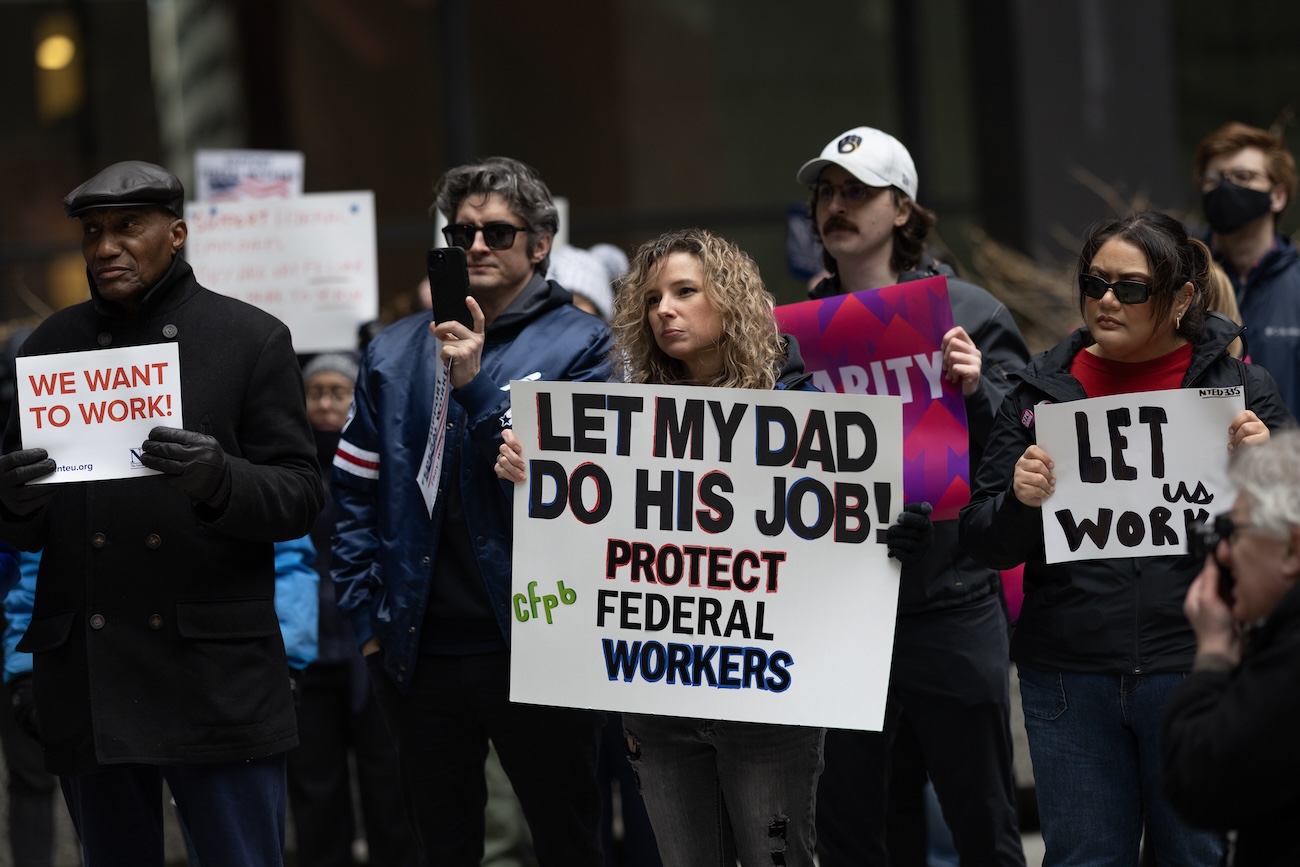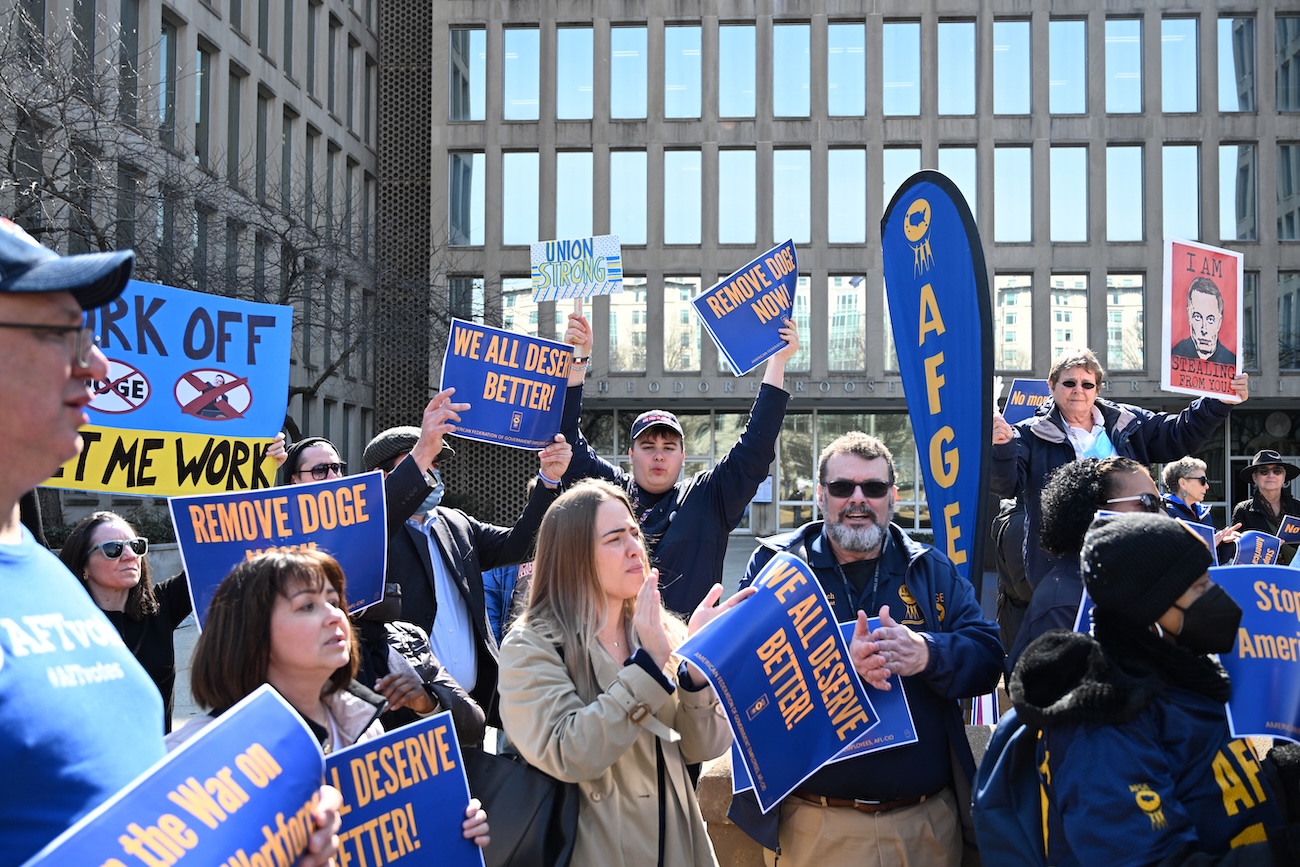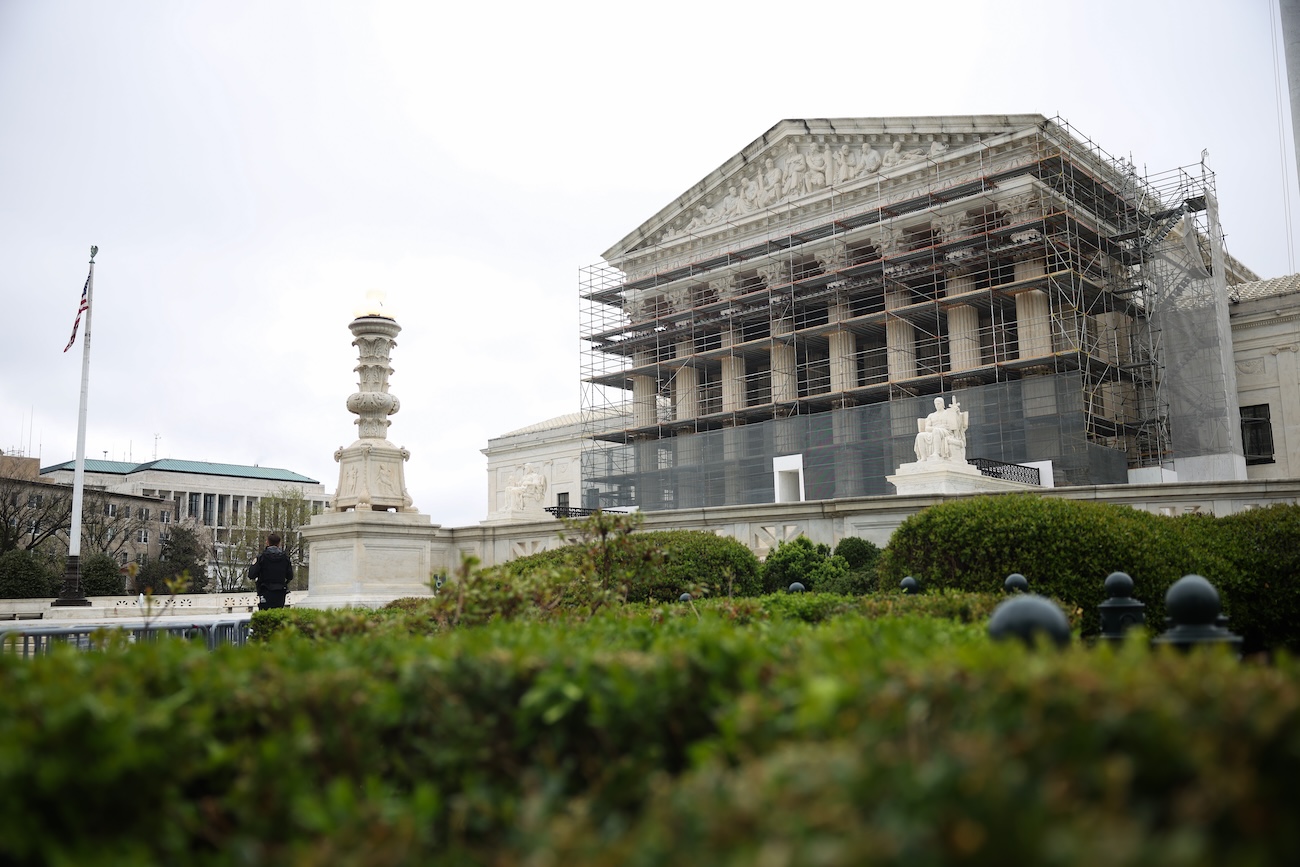Project 2025, a comprehensive policy blueprint backed by influential conservative think tanks, laid out an ambitious plan for the Trump administration to tackle inefficiencies across the federal government.
Since taking office on Jan. 20, President Donald Trump and his Elon Musk-led Department of Government Efficiency have set forth executing that plan in the most chaotic way possible – eliminating entire agencies, firing tens of thousands of workers, and testing the legal system and reach of the executive branch.
Project 2025’s 900-page policy proposal, led largely by conservative groups such as the Heritage Foundation, called for the elimination of the Consumer Financial Protection Board, the reduction in the size and power of the federal workforce by making it easier to fire career civil servants via a “Schedule F” process, instituting a governmentwide hiring freeze, and dismantling federal employee unions. The Heritage Foundation declined a request for an interview, and an email to Project 2025 received a response saying that it had ended and no one was available to respond. However, Project 2025’s former leader Paul Dans told Politico last month that Trump’s decision to implement his plan is “beyond his wildest dreams.”
Musk’s DOGE took that playbook and proceeded to wipe out the CFPB, USAID and other agencies via legally questionable means, purportedly as part of a broader effort to save $1 trillion. He’s done this in conjunction with Russell Vought, the director of the Office of Management and Budget, whose stated intention is for federal workers to be “traumatically affected.”
To date, the Trump administration has either laid off or plans to lay off 280,253 federal workers and contractors – impacting 27 agencies, according to some of the latest data from recruitment firm Challenger, Gray & Christmas, Inc.
These layoffs will have deleterious effects on public services like Medicaid, Medicare and Social Security, and will be felt far beyond the Washington, D.C. area, since nearly 80% of federal employees live and work outside of the nation’s capital.
Given the speed and breadth of these actions, it’s difficult to stay on top of the latest developments. Let us break them down for you:
Workforce Reductions & “Schedule F” Implementation
DOGE began its federal agency reduction efforts with the elimination of all employees in federal agencies who worked on diversity, equity, and inclusion, with these individuals being put on administrative leave. The ACLU and other civil rights groups challenged these firings in a lawsuit.
Then, DOGE announced its voluntary ”deferred retirement” program, otherwise known as the Fork in the Road, offering federal employees the option to resign and get paid through the end of September – which nearly 75,000 feds accepted in February.

In late February, DOGE also fired nearly 25,000 probationary federal workers who were in their first or second years of employment and had fewer civil servant protections. Multiple lawsuits were filed by federal unions, including the National Treasury Employees Union and the American Federation of Government Employees union.
Two District courts in Northern California and Maryland have found these firings were illegal and required the majority of the agencies to reinstate these employees. The administration appealed the Northern California lawsuit representing 16,000 feds to the Supreme Court which sided with the administration as of April 8. But the Maryland ruling still protects the majority of these reinstated probationary workers.
The Office of Personnel Management did not share data on the total number of federal workers who had been fired or were expected to be laid off when requested by Government Executive. DOGE did not respond to a request for comment.
Another line of attack that was originally proposed in Project 2025 and also attempted at the end of the first Trump administration came in the form of the rebranded “Schedule F” process – now known as “Schedule Policy/Career.” This process intends to allow OPM to strip tens of thousands of federal employees in “policy-related” jobs of civil service protections making it easier for them to be fired. Federal agencies are expected to share their plans with OPM by April 20 detailing which policy-related roles should be converted to the lesser protected categories.
Several agencies have already started to notify workers that they were placed in the new civil service role due to the policy-making focus of their jobs, including the Commerce Department’s National Oceanic and Atmospheric Administration. Critics of the new Schedule Policy/Career program say it will move government civil service further from a merit-based system to one that rewards political loyalty, and could lead to thousands of additional layoffs.
Separately, OPM also required agencies to lay out specific plans for reductions in force (or RIFs) by March 13, with the goal of eliminating positions not required in statute totaling around 70,000 employees. OPM has given agencies until April 14 to submit their detailed organizational structures, any relocations of offices, subsequent RIFs, collective bargaining provisions that impact these reductions, technology deployments and how cuts will improve services for Americans.
Several government watchdog groups are concerned about the major cuts ahead, bracing themselves for the worst. “We knew it would be bad, but this administration has really taken it to an even more extreme level,” Joe Spielberger, the senior policy counsel of the Project on Government Oversight, told Government Executive.
Several agencies have already announced their planned RIFs. One of the largest is the Education Department, which plans to cut nearly half of its workforce.
Also, the Health and Human Services Department announced major reductions, saying it intends to cut 20,000 positions (representing 25% of the agency), half of which they aim to achieve through early retirements, buyouts and attrition.
The administration has also started to reopen the deferred resignation program to allow for large federal agencies’ employees to quit their jobs, while getting paid until Sept. 30, and reduce the workforce through voluntary measures.
To keep up with the whiplash of the on-again, off-again firings, Government Executive has an ongoing RIF Watch list tracking the layoffs at major federal agencies.
Agency Dismantling & Restructuring
DOGE has also gone after agencies it claims are too “woke” and unaligned with the Trump agenda. It began with USAID. While Project 2025 sought to rein in the agency’s mandate, DOGE looked to eliminate it entirely. USAID was initially subsumed as a sub-agency within the State Department. Then the administration fired all of its employees. Federal unions sued OPM, and a judge forced the administration to reinstate the majority of the employees. Now DOGE is planning to close down the entire agency by July 1.

Musk’s team has also sought to eliminate the Consumer Finance Protection Bureau, which was on the chopping block in the Project 2025 agenda as well. The agency has returned $21 billion to consumers harmed by scams and fraud from big banks, but also would be responsible for regulating any digital assets that Musk is pursuing with his “X” everything app. While DOGE initially put the employees on administrative leave, a recent court ruling reinstated these employees. DOGE also cut all employees at the Voice of America, but a judge has reinstated these employees as well, for now. VOA was also a target of Project 2025.
President Trump has also called for the elimination of the Education Department via an executive order, although that will officially require an act of Congress, and has been challenged by the federal teachers’ union. The dismantling of the Education Department was also one of Project 2025’s top recommendations.
Meanwhile, more agencies are continuing to roll out planned cuts, including the Agriculture Department – which announced it will dismantle its D.C. headquarters and close field offices throughout the country. Also, the Social Security Administration planned reorganization involves closing some of its regional field offices. And IRS has begun issuing RIFs to its employees, and started off by gutting 75% of its Office of Civil Rights and Compliance.
Unions and government watchdog groups are raising alarms over what these RIFs mean for services to average Americans.
“The Administration has taken a chainsaw to the federal government leaving chaos in its wake with no care or concern about delivering critical services to the American people,” NTEU National President Doreen Greenwald told Government Executive in a statement.
“The administration is undercutting the nation’s ability to provide services to small towns and rural areas; deliver the services to young families, services our seniors depend on, and provide the financial regulation to protect taxpayers’ hard-earned money,” she said.
Union & Collective Bargaining Restrictions
The Trump administration has also set its sights on curtailing the power of federal employee unions. Project 2025 had advised that Congress “consider whether public-sector unions are appropriate in the first place.” Trump first sought to strip the Transportation Security Administration’s collective bargaining rights in early March and was quickly sued by AFGE.

He then used an executive order to outlaw the majority of the government’s collective bargaining authority, using a rarely used federal labor law provision related to national security issues and impacting two-thirds of the federal government. It applied to the Defense, State, Veterans Affairs, Justice and Energy departments, as well as portions of the Homeland Security, Treasury, Health and Human Services, Interior and Agriculture departments. It also applied to smaller agencies like USAID, and the Federal Communications Commission.
AFGE and NTEU both sued challenging the executive order.
“For over 47-years, the law has made clear that collective bargaining in the federal sector is in the public interest. We have taken the necessary action to file a lawsuit to uphold the law and stop this attack,” NTEU’s Greenwald said in its statement to Government Executive.
Return-to-Office Mandates & Workplace Changes
Not only has the Trump administration sought to mandate return-to-office requirements across the federal government, but it’s also simultaneously trying to reduce the number of federal office buildings that house these workers.
The move intended to make it harder for those employees who had been granted remote working privileges in the pandemic by requiring them to report to offices within 50 miles of their designated duty stations. While the administration has allowed the agencies to set their own timelines for full-time in-person work, they have been implemented somewhat haphazardly with different degrees of strictness per agency.

The General Services Administration and DOGE initially sought to close 50% of all government office spaces, but that number has reduced over time. It had listed hundreds of federal buildings to close, and in March updated that number to 440 “non-core” federal properties for potential closure. It’s also seeking to cancel leases as a way to cut government spending.
Workforce Pipeline Issues
Upon his first day in office, Trump instituted a hiring freeze across almost all federal agencies, and with the buyouts and RIFs, it will be difficult to fill many vacancies as people continue to leave the administration.
He said it will make future recruitment and retention of government workers almost impossible — which seems to be the underlying goal of these cuts, making the prospects of government service “as unappealing as possible.”
“I can’t imagine how an agency would actively try to recruit among the best and the greatest, into positions with fewer rights, fewer job protections, when this administration is actively gutting or undermining those who play important roles in protecting people’s rights,” he said.
Spielberger also said he expects a major brain drain from the government.
“If you’re talking about scientists and researchers, or any of these experts who are committed to their careers and committed to public service – oftentimes taking pay cuts in order to join the civil service – it’s hard to imagine long term the impacts that will be felt in every agency across the government,” he said.
Lawsuits and Long-Term Degradation of Public Service
What’s next for federal government employees will continue to unfold in the coming weeks. The second stage of reduction in force plans from agencies cutting hundreds of thousands of employees are due to OPM on April 14. And by April 20, agencies are officially required to submit their plans to reclassify as many as 50,000 federal employees who are in policy-making roles – potentially leading to even more reductions in force.
Key legal challenges will continue to wind their way through the courts. Including two cases involving Trump’s firing of 25,000 probationary employees, which was appealed by the administration to the Supreme Court. On Tuesday, the high court ruled that some of those employees may remain fired, for now, but are still reinstated in a separate court ruling.
Federal unions like NTEU and AFGE and other government oversight groups defending federal workers have currently filed dozens of legal challenges to the Trump administration’s efforts to cull the federal workforce and ban federal employee unions. That includes new lawsuits from federal unions challenging DOGE’s renewed buyout offers – which a judge in February previously ruled were legal.

KAYLA BARTOWSKI/GETTY IMAGES
Another key target to watch in the weeks ahead is the expiration of Musk’s official “special government employee” status. As an SGE, he is legally limited to working for the administration for 130 days – putting his end date in late May, which the White House has admitted is coming up.
But POGO’s Spielberger said he thinks Musk’s public removal will largely be symbolic, and he expects Musk and DOGE will continue to be involved in an unofficial capacity going forward.
Regardless of Musk’s status, the long-term effects of DOGE will have reverberating impacts for generations to come — making it less likely people will want to enter the public sector, watchdogs and unions say.
“As we watch the haphazard firing of thousands of our neighbors, family and friends who are highly skilled civil servants that deliver services across the nation, we know that the long-lasting devastation of these acts are only beginning to be realized,” NTEU’s Greenwald said in the statement to Government Executive.
Watchdogs are also raising concerns that the remaining civil service employee workforce – which has traditionally been apolitical – will become more partisan.
“What you’ve got is an administration that wants to see federal employees come in and out very tied to an administration and its policies,” said Jenny Mattingley, vice president for government affairs at the Partnership for Public Service. “We think it should be merit-based, nonpartisan, and there should be some guardrails against politicization.”
Similarly, Spielberger fears what could come next is that the remaining employees may have to be forced to decide whether they want to pledge allegiance to the administration — or continue to uphold the Constitution and serve in the best interest of the people, which are increasingly coming at odds.
Others worry that the federal service reductions will end up costing American taxpayers more, due to inefficiencies in firing and rehiring employees, and because agencies may have to hire more expensive contractors and increase federal salaries to make public service attractive.
Looking ahead, John Hatton, vice president of policy at the National Active and Retired Federal Employees Association, said, “I think you’re no longer going to have greater job security and potentially have to pay people more. People aren’t going to have the same loyalty like they used to.”
NTEU’s Greenwald says cutting feds ultimately hurts all Americans.
“In addition to the harm to public services, the administration is in danger of wiping out an entire generation of civil servants who will be denied the opportunity to put their skills to work for the public good, and that is a loss for our country,” she said in a statement.
Rebecca Kern is a freelance writer in Washington, D.C., and until recently was a probationary employee at the Federal Trade Commission.




